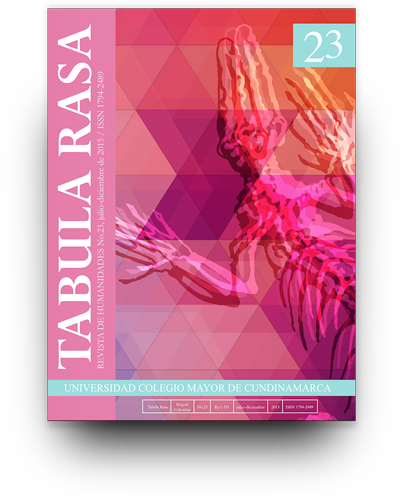El hombre hicotea and the ecology of waterscapes in Resistencia en el San Jorge.
El hombre hicotea y la ecología de los paisajes acuáticos en Resistencia en el San Jorge.
Show authors biography
This article examines representations of waterscapes (rivers, tributaries, swamps) in Resistencia en el San Jorge, the third volume of Historia doble de la costa by Orlando Fals Borda. Using the text as well as Fals Borda's field notes, this article argues that Historia doble de la costa consciously incorporates the ecology of the natural environment of the Depresión Momposina into the region's history of popular resistance. The ecological crisis perpetrated by historical capitalist expansion is presented in Resistencia en el San Jorge as part of the larger history of struggles for land and social justice in the Atlantic Coast region of Colombia.
Article visits 225 | PDF visits 168
Downloads
- CDRBR/M, Archivo Orlando Fals Borda, Centro de Documentación Regional. Banco de la República-Montería, Córdoba.
- Appelbaum, N. P. 2013. "Reading the Past on the Mountainside of Colombia: Mid-Nineteenth Century Patriotic Geology, Archaeology, and Historiography". Hispanic American Historical Review, 93(3): 347-376.
- Archila Neira, M. 1984. Reseña de "Historia doble de la Costa". Boletín Cultural y Bibliográfico 2: 111-114.
- Archila Neira, Mauricio. 2003. Idas y venidas, vueltas y revueltas: Protestas sociales en Colombia, 1958-2000Bogotá, D.C.: ICANH/CINEP.
- Archila Neira, M. 2002. 25 años de luchas sociales en ColombiaBogotá, D.C.: CINEP.
- Bergquist, C. 1990. "In the name of history: A disciplinary Critique of Orlando Fals Borda's Historia doble de la Costa". Latin American Research Review 25(3): 156-176.
- Charlarka G., U. 1985. Historia gráfica de la lucha por la tierra en la Costa AtlánticaMontería: Fundación del Sinú.
- De Castellanos, J. 1857. Elegías de varones ilustres de Indias (2ª. ed.). Madrid: M. Rivadeneyra.
- Denevan, W. M. 2001. Cultivated Landscapes of Native Amazonia and the Andes: Triumph Over SoilNew York, NY: Oxford University Press.
- Denevan, W. M., ed. 1989. Hispanic Lands and People: Selected Writings of James J. ParsonsBoulder, CO: Westview Press.
- Fals Borda, O. 1979. Historia doble de la costa, tomo I: Mompox y LobaBogotá: Carlos Valencia Editores.
- Fals Borda, O. 1981. Historia doble de la costa, tomo II: El presidente NietoBogotá: Carlos Valencia Editores.
- Fals Borda, O. 1984. Historia doble de la costa, tomo III: Resistencia en el San JorgeBogotá: Carlos Valencia Editores.
- Figueroa, J. A. 2007. Realismo mágico, vallenato y violencia política en el Caribe colombiano (vol. 1 de 2). Ph.D dissertation, Department of Spanish and Portuguese, Georgetown University.
- Kamen, H. 2004. Empire: How Spain Became a World Power, 1492-1763New York, NY: Perennial.
- Leal León, C. 2005. "Presentación del dossier sobre historia ambiental latinoamericana" [Versión electrónica]. Historia Crítica, 30: 5-11.
- McNeill, J. R. 2000. Something New Under the Sun: An Environmental History of the Twentieth CenturyNew York, NY: W. W. Norton and Company.
- Mires, F. 1990. El discurso de la naturaleza: ecología y política en América LatinaSan José, Costa Rica: Editorial Departamento Ecuménico de Investigaciones.
- Negrete Barrera, V. 2007. "¿Hidroeléctrica de Urrá II? El ejemplo de Urrá I y la situación actual no lo aconsejan". Revista Interacción 47. Retrieved June 15 2015 from <http://www.cedal.org.co/index.shtml?apc=h1b1---&x=668&cmd%5B126%5D=c-1-%2747%27>.
- Nieto, J. J. 1839. Geografía histórica, estadística y local de la provincia de Cartagena República de la Nueva Granada, descrita por cantonesCartagena: Imprenta de Eduardo Hernández.
- Ocampo, G. I. 2007. La instauración de la ganadería en el valle del Sinú: la hacienda Marta Magdalena, 1881-1956Bogotá: Editorial Universidad de Antioquia, ICANH.
- Parsons, J. J. & W. Bowen. 1966. "Ancient Ridged Fields of the San Jorge River Floodplain, Colombia". In William Denevan, ed. Hispanic Lands and People: Selected Writings of James J. Parsons (pp. 177-208). Boulder, CO: Westview Press.
- Phelan, J. L.. 1978. The People and the King: The Comunero Revolt in Colombia, 1781Madison, WI: University of Wisconsin Press.
- Plazas, C., A. M. Falchetti, T. Van Der Hammen & P. Botero. 1988. "Cambios ambientales y desarrollo cultural en el Bajo San Jorge" Boletín del Museo de Oro, 20, Montería: Banco de La República. Retrieved from http://publicaciones.banrepcultural.org/index.php/bmo/article/view/7167/7425.
- Striffler, L. 1920[1880]. El río San Jorge, aumentando con una relación histórica y geográfica de sus principales poblaciones por Eugenio Quintero A. Cartagena: Tipografía de El Anunciador.
- Whitehead, N. L. 1999. "The crisis and transformations of invaded societies: The Caribbean, 1492-1580". En Stuart Schwartz and Frank Salomon, eds. The Cambridge History of the Native Peoples of the Americas (Volume 3: South America, Part 1) (pp. 864-903). Cambridge: Cambridge University Press.
- Wolf, E. R. 1999[1969]. Peasant Wars of the Twentieth CenturyNorman, OK: University of Oklahoma Press.




